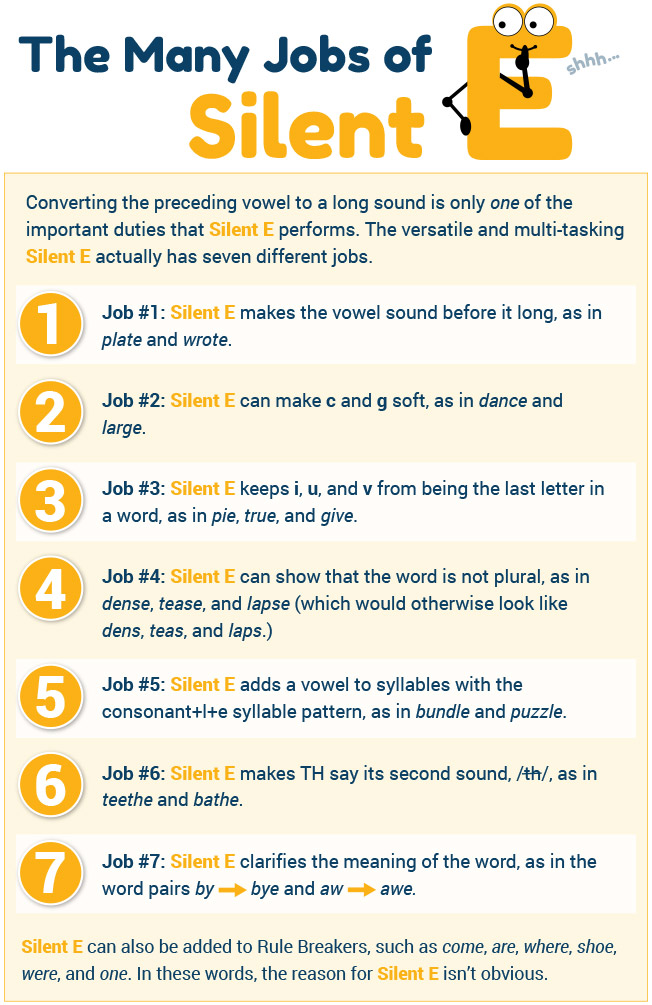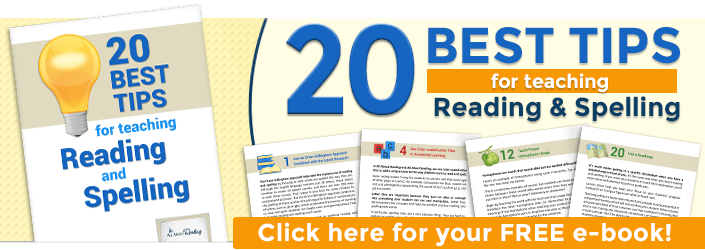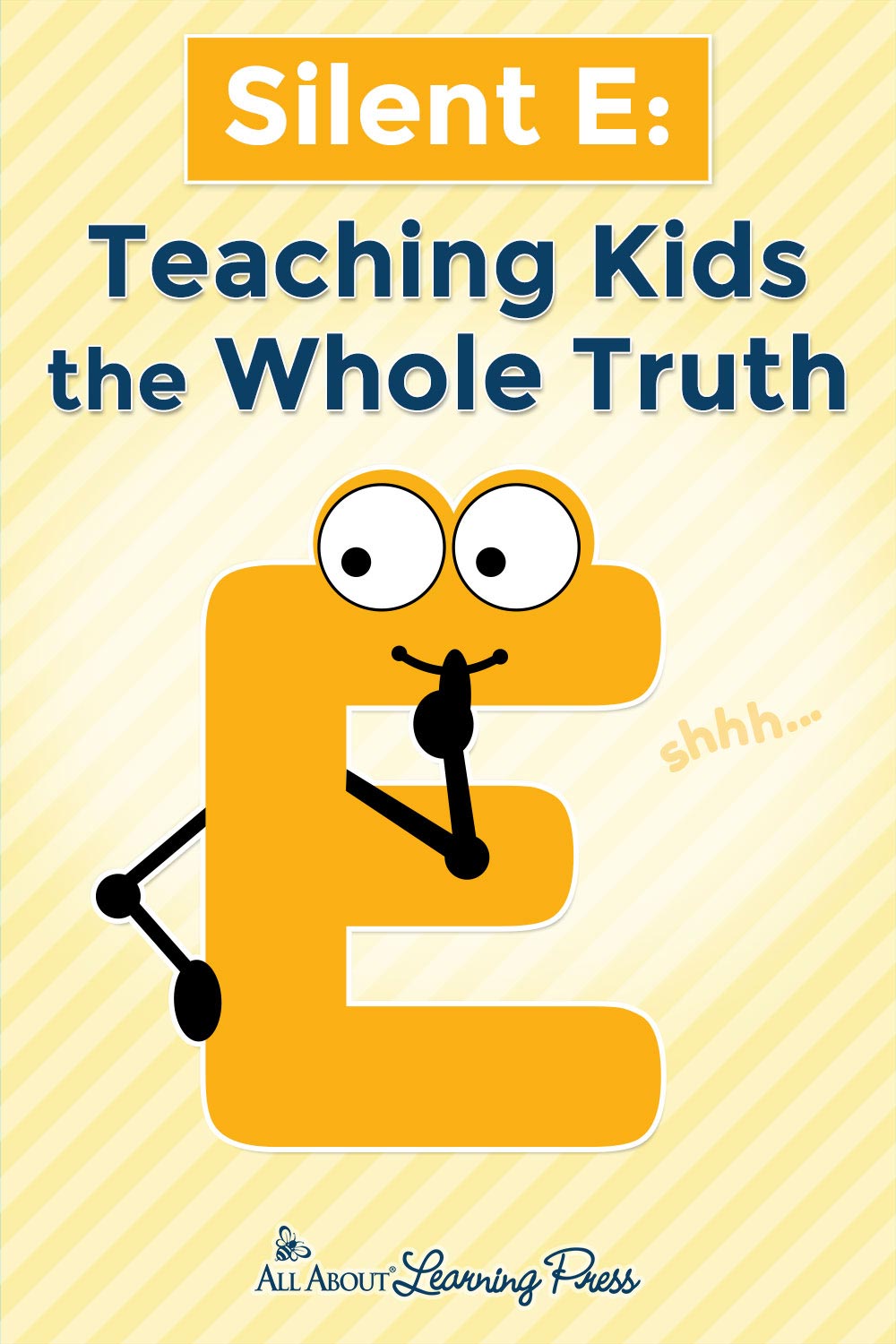Silent E: Teaching Kids the Whole Truth

“Silent E makes the vowel say its name.”
And if you look at the following word pairs, that rule does appear to be true.
tap --> tape
fin --> fine
mad --> made
But today we’re going to bust this popular phonics myth.
In each example, Silent E changes the short vowel into a long vowel (in other words, the vowel says its name). Dozens of popular phonics programs teach this, and it is one of the most common reading and spelling “rules” taught to beginning learners.
This would be a good rule if it were the whole truth.
The Truth about Silent E
But that’s where the problem arises: after kids learn this rule, they encounter hundreds of words that don’t fit into this easy pattern. They start to see words all around them, such as horse, love, and puddle, in which Silent E doesn’t make the preceding vowel long…and then they start to doubt what they are being taught.
Some students are naturally intuitive when it comes to language patterns, and they can fill in the gaps and move on. But many students take the “rule” at face value and think that the problem is with them—that they just can’t figure out English.
This situation is frustrating and unnecessary, because…
Silent E Has Many Jobs
The chart below shows seven jobs of Silent E, along with sample words.

Saying “Silent E makes the vowel say its own name” is like saying “dogs are black.”
Would your child believe you very long if you tried to convince him that all dogs are black? While it is true that some dogs are black, it is not true that all dogs are black. Dogs can be brown, white, sable, yellow, or mixed.
In a similar vein, not all Silent E’s do the same job. Sometimes they make the preceding vowel long, but they can also do six other jobs.
Teaching the Truth of Silent E
When students know the truth—the full story about Silent E and all of its jobs—they aren’t thrown off when they see Silent E at the end of a word. If it doesn’t make the preceding vowel long, there are other options to explain its existence. Students can trust their education, instead of being misled by a myth.
Knowing the truth also opens the door to some interesting word discussions. For example, did you know that Silent E can do two jobs in a single word? Check out the word race—Silent E makes the A long and makes the C soft. Other examples in which Silent E has two jobs include hive, mice, trace, page, and cage. That’s pretty neat!
How We Teach Silent E
In the All About Reading and All About Spelling programs, we teach all the jobs of Silent E. (In AAS, the jobs are numbered differently because we lumped some together in the “Handyman E” category.) We teach the jobs step by step, one lesson at a time, so students can master the concepts at their own pace.
Are you interested in seeing some sample lessons? Click to download!
Were you ever taught the various jobs of Silent E?












Nancy McGuire
says:This is very helpful for my small reading intervention groups, thank you.
Robin
says: Customer ServiceNancy,
I’m glad this is helpful for your students! You’re welcome.
Natasha
says:Can anyone guess why vaccine has a silent e?
Robin
says: Customer ServiceGreat question, Natasha!
We cover this in All About Reading Level 4 and All About Spelling Level 7.
-ine is a suffix used a a lot of English words. It can be pronounced with either the long E sound as in vaccine (which is more of a French influence) or, more commonly, with a short I sound as in imagine. It may be best to think of the silent E in such words as the unclear reason (the rule-breaker words mentioned at the bottom of the infographic). However, it is also correct to think of the silent E as doing it’s first job of making the vowel long, but the pronunciation of this suffix has shifted greatly over time. A lot of suffixes have suffered that. Think of -ive in words like active, -ice in office, -ite in favorite, and the common American pronunciation of -ile in words like mobile and missile.
I hope this helps!
Joanne
says:I have a list similar to this, but I’m wondering about words like “opposite” and “engine”. What is the job of silent e in these words? Based on etymology, I can only guess that the pronunciation of the in both words used to be long? Any thoughts on this?
Robin
says: Customer ServiceGreat questions, Joanne!
Opposite has a silent E because the suffix -ite says long i when it is an a stressed (accented) syllable like crystallite. But when it’s in an unstressed syllable, it takes on the schwa /ih/ vowel sound like opposite. All About Reading covers this in the second half of Level 4.
The -ine of engine is much the same, with the added issue that in stressed syllables it can be long i as in alkaline or long e as in magazine. The long e is more in words of French origin, however. This is also covered in All About Reading Level 4.
Here is an article on How to Teach Schwas that may help.
Masashi Ng
says:About the 3rd job of silent E, it creates a vowel team for the I and U, not prevent them from being the last letter of the word. The 8th job of silent E should be to create a vowel team. For example, “foe” and “Joe” creates a vowel team after OE.
Cristie
says:I agree with this take. I was taught “two vowels together, the first one says its name and the second is silent.”
Robin
says: Customer ServiceCristie,
You may find our When Two Vowels Go Walking article interest. It discusses how this “rule” is reliable less than half of the time!
Robin
says: Customer ServiceMasahi,
Interesting take on Silent E. There are some options with teaching the patterns of English.
G. S Mashani Maduwanthi
says:This really helped my career
Jess
says:This curriculum has really helped my daughter who struggled with our previous spelling curriculum, which was based more on phonics rules she was learning at the time. We’re finishing level 3 now, and my daughter is wondering what the job of silent e is in words like core, sore, and more. Any ideas?
Robin
says: Customer ServiceJess,
I’m so pleased to hear that your daughter is really thinking about words like this. Thinking about words is so important for better spelling!
Do you say core and more to rhyme with for? Is she thinking why do we need a silent E when the words could all be spelled with just the OR phonogram (cor, sor, mor)?
The silent E in core, more, and sore are all to make the O long, Job #1. The spelling of -ORE is much more common for the /or/ sound at the end of a one-syllable word than OR is.
As she is learning in All About Spelling, there are multiple ways to spell many of the sounds in English (she will learn in time that there are 9 ways to spell the long E sound!). Well, OR and ORE are two ways to spell the /or/ sound. Note, in the words core, more, sore, etc. the OR phonogram is not used. It is the O phonogram followed by the R phonogram and then the E phonogram.
Does this clear things up for her? (Let me know If I guessed wrong at her thought process. It is also somewhat common to pronounce such words as having two syllables, so that more and mower sound much the same).
Jess
says:That’s a great explanation! Thanks so much for your thoughtful response. That’s the pronunciation we use.
MJB
says:All About Spelling has been a godsend for us! It was the key to finally unlock my son’s ability to spell.
Robin
says: Customer ServiceI’m so pleased to hear that All About Spelling has been so helpful for your son! Thank you.
Jessica Barnes
says:We’re doing aas level 2 and working on the vowel team ee. Is there a way to tell when the long e sound is the vowel team versus a silent e making e say its name? Thanks!
Robin
says: Customer ServiceGood question, Jessica.
No, there is no rule for knowing when the sound of long /ē/ sound is spelled. However, first know that E-consonant-E is a very uncommon pattern. There are some common words with it (like Steve and here), but it is otherwise rarely used.
What is more difficult for most children, is knowing when to use E or EE. Why is tree spelled with EE and be spelled with E? There is no rule for that either (the answer lies far back in the word’s history).
It is not uncommon for beginning spellers to get confused when you introduce another pattern. I would do a special word-sorting lesson with your student. You’ll need to do a bit of prep ahead: pull out the word cards that have the long E sound spelled with just an E, with double E, and the word here (I think that’s the only word card you have for E-consonant-E pattern). If you still have your level 1 cards, pull words from there like me and we, and then also pull the level 2 words like belong, begin, prevent, even, zero, refund, etc. Put them in a stack and shuffle them so they are mixed. Make 3 labels on paper or blank index cards: E, EE, and E-consonant-E. Now you’re ready to do the lesson with your child.
Tell your student, “We have learned 3 ways to spell the long E sound. Do you remember what they are?” (You can let him see the labels and read them, or he might be able to remember them on his own.) “Good! Let’s read these word cards and sort them into piles based on how they are spelled.” Show him the stack of word cards you made, and have him read each of the words and put them under the label for each pattern.
“There aren’t very many words that use E-consonant-E, are there? That pattern is pretty rare!”
“Let’s look at these words that use just a single E. Why is the E long in these words?” (The vowel is long in an open syllable.)
“That’s right! Let’s build one of these with the tiles. Which one do you want to make?” (Let him choose one and spell it with the tiles. It’s okay if he’s looking at the word card as he builds it this time since you want to reinforce the single E.)
“Good job! Now, how would we divide this word into syllables?” (See if he can divide it into syllables, and then have him label each one.)
Then you can have him also spell one of the EE words. Pick one that ends in a consonant, like week. Have him label it with the syllable tag for the vowel teams. Ask, “Would it work to use just one E here?” (No, the e would say /ĕ/ like bet.) “That’s right! We need the vowel team here.”
Show him the word tree. “Sometimes we also use EE at the end of a syllable. If we used a single E here, would it make the right sound?” (Yes it would.) “So for a few words, we just have to learn that they need two E’s. Most of the time we’re going to use one E at the end of a syllable though, so just memorize the exceptions (tree, see, three.)” (From the more words, he would also memorize bee and free. If he knows about the words be and bee, talk about how the double E helps us to know what word we mean, since each one has a different meaning. If he doesn’t know that yet though, this will be addressed in Level 3 when homophones are introduced.)
You can do all of this over a few days if you need to–you don’t have to do it all in one day if he’s getting confused or frustrated. You can also work on just one set of words at a time, like just the single E words, and have him practice just reading those word cards for a week. Each day ask a question like, “How is the long E sound spelled in these words?” as he’s looking at the card. Asking a question can help him take more notice of the pattern. The word cards can be like a word bank in this way. After he reads and notices the pattern for several days, then have him try spelling the words again.
Does this give you some ideas on how you might proceed? Keep encouraging him and give him as much help and pre-coaching as he needs until he’s able to spell these correctly on his own. He’ll get there!
Please let me know if you have additional questions!
Garrison
says:Do you teach the syllable types? I think I see that you go from open and closed to r-controlled, thus skipping vce. Didn’t OG intend for vce syllable type to be taught in the first three?
Robin E.
says: Customer ServiceGarrion,
All About Reading and All About Spelling both teach six syllable types. They are closed, open, vowel-consonant-E (Name Game), vowel team, R-controlled (Bossy R), and consonant + LE (Pickle). The VCE syllable is the third syllable type taught in both programs.
The VCE syllable type is called “Name Game” syllable All About Reading. The curriculum developers found this name easier children to remember and less confusing as VCE and C+LE look and sound similar. AAR also calls the C+LE syllable type “Pickle” syllable, and uses “Bossy R” rather than R-Controlled.
Ashley Swegles
says:Iv went back and forth with this alot. Wouldn’t it be easier to learn words by memory? As an adult I don’t remember any of the rules, I just read from memory and I’m a good reader.
Robin E.
says: Customer ServiceAshley,
Research strongly suggests that proficient readers do not read from memorizing words as we think, but rather they have internalized the rules and patterns of language so well that they are unaware of it. This is why we can read nonsense words like plunt and yat instantly, even though we never learned them.
There is something called the “Curse of Knowledge” that sometimes comes into play as we teach. Our blog article on it may be helpful for you, but basically, it is that when we know something on a mastery level, we often forget all the steps and incremental pieces that went into learning it.
It is estimated that students need to be able to read and comprehend at least 8000 words to be able to successfully read novels, newspapers, and other media. That is a lot of words to learn all by memory, and since there are well over 100,000 words that can be used in English, students also need skills for how to approach words they do not know.
You may wish to look into what research says about the science of reading and how children learn to read well. If you have questions or need more information, please let me know.
Cheryl T. Kreutter
says:If rules are myths, why would one spend time teaching all 6 of them? Also, if the goal of reading is comprehension, how can we integrate other variables involved in reading with decoding/encoding?
Something to keep in mind with Orton-Gillingham is there is no empirical research that supports its effectiveness. In fact, despite 90 years of use, there is little other than testimonial evidence that this approach has been successful. The O-G based approach was found to be no more effective than other types of intervention in improving reading comprehension among third and fifth grade struggling readers despite a year of instruction using the approach. A study included in the National Reading Panel (NRP) report even demonstrated a substantial negative impact on comprehension a year after students participated in an O-G-based intervention.
National Reading Panel. (2000). Teaching children to read: an evidence-based assessment of the scientific research literature on reading and its implications for reading instruction. Bethesda, MD: National Institute of Child Health and Human Development. (p. 2-160)
Merry
says: Customer ServiceHi Cheryl,
Thanks for your comments! As we explain above, the myth is thinking Silent E only has one job, rather than understanding all of the ways Silent E can work. AAR and AAS give students complete information on how Silent E functions.
With regard to the National Reading Panel report, page 2-119 explains that they found that all phonics-based approaches they studied (including the Orton-Gillingham approach) “produced significantly greater growth in reading than control group programs.” They further explain a likely reason for the lower score that O-G programs received was that students received classroom-wide instruction instead of one-on-one instruction. These students were already identified as struggling readers and low achievers—that type of student especially needs one-on-one instruction that can be tailored to the student, which is one of the hallmarks of the Orton-Gillingham approach! On page 2-156, you can see that the one O-G study that came out negative was with low-achieving 5th graders that received classroom-wide instruction instead of individualized instruction.
True Orton-Gillingham-based instruction needs to be multisensory, sequential, incremental, cumulative, individualized, phonogram-based, and explicit.
All About Reading incorporates both the Orton-Gillingham Approach and the findings of the National Reading Panel. Please see our blog article, 12 Reasons Teachers Love All About Reading and All About Spelling where you can read more about the research-based methods that All About Reading and All About Spelling incorporate.
And here is information on How to Teach Reading Comprehension.
I hope this helps!
Sibongile
says:Thank you very much I really appreciate. I was not aware of the 6 rules of silent E. I was familiar with the E rule which states silent e change the short vowel into a long vowel.
Robin E.
says: Customer ServiceYou’re welcome, Sibongile. I was also taught that Silent E changes the vowel sound, but not taught the other jobs. My kids are much better off than I was knowing all the jobs of Silent E!
namita saraf
says:Great concept is share here.where i can find this whole concepts of handbook as i m teaching my daughter at homeso sometimes you know i dont have answers to her questions
Robin E.
says: Customer ServiceNamita,
There is a lot of complexity in English. We cover all these concepts in-depth and step-by-step in our All About Reading and All About Spelling programs.
Kate
says:Silent e does not make C and G soft ever. The rule is that when e, i, and y come after C or G it is usually a soft sound. Has nothing to do with the e being silent. There are irregulars in every English rule taught. What research or data are you basing your 7 rules on? In all my years teaching phonics and attending a multitude of seminars and workshops, I’ve never heard of this.
Robin E.
says: Customer ServiceKate,
Thank you for pointing out that C says it’s soft /s/ sound before E, I, or Y, and G may say it’s soft /j/ sound before E, I, or Y. All About Reading and All About Spelling teach these rules in detail.
In words like chance and gorge, the C and G are followed by an E and they give their soft sounds. And, the E in both is silent. If the purpose of the silent E in these words is not to make the C and G say their soft sounds, then why do these words have a silent E? The purpose of teaching multiple jobs for silent E like this is to remove the confusion as to why so many words have a silent E even though they do not have a long vowel.
One of my daughters had a terrible time with silent Es because the program we used didn’t give a reason like these jobs for why some words have a silent E. She thought they were just added randomly to some words, and so she would do things such as spelling the word back “backe”. After just a few months of All About Spelling, she no longer had trouble with when to use a silent E.
Both All About Reading and All About Spelling are Orton-Gillingham based. Marie Rippel, author and creator of the programs, is a member of the International Dyslexia Association and has instructed graduate-level courses in Orton-Gillingham Literacy Training offered through Nicolet College in Rhinelander, Wisconsin. She has previously served on the Board of Directors of the Literacy Task Force in Wisconsin and tutored students for more than 20 years.
Sheryl Manolakos
says:Great
Jennifer Harris
says:This is a wonderful resource! Our 4 year old loves the Silent E song, but my husband and I couldn’t answer his question of why “love” breaks the rule. Now we can! Thank you!
Robin E.
says: Customer ServiceYou’re welcome, Jennifer! I, too, found learning ALL the possible jobs of silent E made teaching my children so much easier!
Elise Wile
says:This is so very illuminating! I was just preparing a list of r-control words for my first graders, and couldn’t figure out why there is an e at the end of more, tore, chore, bore, gore, etc. Is there a specific rule for that?
Kristen
says:That is interesting because it’s not a soft sound like socks. It kind of sounds long. Maybe teach kids when it’s together with an r, it always sounds like or/ore. Those are the same and the e is silent in ore.
Olymtmom
says:Hello, thank you for this printable Silent E chart. I’m having a difficult time explaining the pickle syllable rule to my child and what to look for when dividing a word into syllables. Open and closed syllables and syllable division using the one or two consonant rule seem more obvious to my child. Any additional explanation would be greatly appreciated. Thank you 😊
Robin E.
says: Customer ServiceAre you using All About Reading or All About Spelling? Both of these programs have detailed lessons on the Pickle Syllable (or Consonant-LE syllable as it is called in All About Spelling). It is found in Lessons 8 and 10 of All About Reading Level 3, or Steps 5 and 6 of All About Spelling Level 3.
In short, the rule for this syllable type is, “When a word ends in a consonant then LE, count back three tiles from the end and divide.” Here are three examples:
maple – Count back three tiles and divide the word as ma-ple. Then it becomes clear the first syllable is open, so the A is long.
rubble – Count back three tiles and divide the word as rub-ble. The first syllable is closed, so the U is short.
feeble – Count back three tiles and divide the word as fee-ble. The first syllable is a Vowel Team syllable, so the vowel team EE says its typical sound.
I hope this helps. Let me know if you have additional questions.
Ron
says:We need a place for adults to communicate the issue with learning. How does one over come the issues in spelling and gramma?
How does etymology help spelling? What tools should a adult use to help with gramma and spelling?
Do you have a contact for adult student to fix their learning gaps. Adults need help to, what do we do to help adults?
Robin E.
says: Customer ServiceRon,
Our materials can be and have been used to successfully teach adults to succeed with reading and spelling. More than anything, however, students of all ages need teachers to help them be successful with mastering reading and spelling. These subjects cannot be mastered without someone to notice not only the errors but also the cause of the error and to help the student understand that. The feedback a caring teacher gives is invaluable!
Our materials are designed to be easy to use without special training or previous teaching experience. Check out How We Make Reading and Spelling Easy to Teach.
If you have additional questions on how to adapt our materials for adult learners, please let me know.
shabana
says:Great information
Robin E.
says: Customer ServiceThank you, Shabana.
jerry miller
says:Thank you for your great post!
Robin E.
says: Customer ServiceYou’re welcome, Jerry!
Naomi Yu
says:Thankyou for sharing this. It’s great to know the whole story.
However I still teach the magic e rule to my ESL students when I need them to start comprehending this long vowel pattern. I also explain that some words ending in v don’t follow this rule because they are words they will see in their speaking textbooks again and again from beginner level (love, have, live). Also, I teach the soft c and g rule as a separate phonics rule as the truth is that the silent e in these words does still indeed make the vowel long. I teach that the c and g are (usually) made soft not only before the silent e, but the letter e generally (cement, celery) + the letters i (icy, city) and y (cycle, cylinder).
As great as this chart is for adults, it’s aloooot of information for a little person to remember. Especially an ESL learner. Simple, general rules building on each other, like magic e, then the ‘v’ issue, then (later) the ‘th’ rule etc… seem better suited for my scenario.
As always thankyou for the detailed info though. As a teacher it’s great to consider these articles and how they apply in my personal small group ESL setting.
Robin E.
says: Customer ServiceYou bring up such a great point, Naomi!
Yes, when teaching students just learning to read and spell, you cannot just throw all this information at them at once. It is information overload! (Marie describes it as overwhelming the student’s funnel, see our blog post How the “Funnel Concept” Affects Learning.)
All About Reading and All About Spelling approach the many jobs of Silent E in much the same way you have described, slowly over time, with space to master each concept before the next is introduced. Level 2 of All About Reading just teaches the first four jobs, spread out over the entire level. And, as you mentioned, soft C and G when followed by E, I, or Y, is taught with the second job of silent E.
This blog post is an overview of the complete picture of silent E, which is helpful for teachers and for reviewing. But each job should be taught separately and students should be comfortable with one before the next is added.
Thank you for sharing your insights!
Naomi Yu
says:Thankyou for replying and giving more info about how these rules are covered in the All About Reading curriculum. It looks like a really great program.
Loveth Paul
says:This is so helpful. Thanks for sharing
Robin E.
says: Customer ServiceI’m glad this was helpful! You’re welcome.
Alodia Abarca Igloso
says:thank you so much for sharing. this is so important to me and a great help in my teaching in Elementary
Robin E.
says: Customer ServiceYou’re welcome, Alodia. I’m glad this is a help for you in teaching!
Sheetal Sanghvi
says:Biggg thank you for such informative, educative and interesting posts and printables.
Robin E.
says: Customer ServiceOh, you are very welcome, Sheetal! Thank you.
Melissa
says:This is soo helpful. There are so many rule, so having an attractive infograph with examples has helped our sons.
Robin E.
says: Customer ServiceI’m pleased to hear that this infographic has been helpful for your sons, Melissa! Thank you.
Jacquelyn gunsser
says:Just found this site really enjoyed this
Robin E.
says: Customer ServiceThank you, Jacquelyn!
jooliet
says:Yes! This is great thanks. The split digraph rule is not the only thing to consider.
claire
says:i love your program
Jennifer Griffin
says:Thank you!
Jennifer Griffin
says:We are on level 2, lesson 42. I thought I read somewhere that the silent e cannot jump 2 consonants to make the vowel say a long sound. Is this true? I have searched the manual and cannot find where I thought I read this.
Robin E.
says: Customer ServiceJennifer,
We teach words where a silent E makes a vowel long over two consonants in All About Reading level 2 lesson 49. We have the teacher build the word taste for the students and then say:
“In this word, Silent E asks the A to say its name. Usually, there is just one consonant between the vowel and Silent E, but sometimes there are two consonants between them.”
Only a few words will have the -aste ending where the A will be long, so it’s not a common pattern at all but it does happen. However, I have seen other places (not All About Reading or All About Spelling) that teach this “rule”.